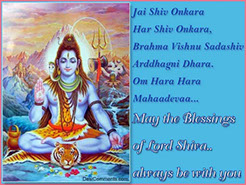



108 Names of Bharat Mata Video
108 Names of Bharat Mata
Gayatri Mantras Video
Bharat Mata Gayatri Mantras
Ekavimski Video
Bharat Mata Ekavimsati Song

Click on Link below to go to Youtube Videos
To download MP3 Audio right click and "save link as"
Home
About the Author
108 Names of Bharatamata
Gayatri Mantras
Ekavimsati Song
Speaking/Media Contact
Sri Bharatamata
Ashtottaram 94
94) OṀ MANTRA BHŪMYAINAMAH:
OṀ (AUM) -MAN-TRA- BHOO- MYAI- NA-- MA- HA
(Mantram: means-'That which protects when reflected upon', to repeat in mind,
the sacred formulae)
One of the most widely used words in Sanskrit religious literature is the word 'mantra.' It is, etymologically speaking, defined as that which protects (tra=to protect) when repeated and reflected upon (man=to think, to reflect). This word has two meanings: the poetical part of the Vedas, and the names and syllables used to indicate or propitiate deities. The former is Vedic and the latter is tāntrik. The Vedas are generally divided into two broad divisions: The mantra part of the first three Vedas is again classified as Ruk, Yajus, and Sāman. The Brāhman.as are in prose, deal with the details of sacrificial rites and quote the appropriate mantras (sacred formulae) to be used in the rites.
In the Mantra section, a fourth category, the nigaḋa, is sometimes added. Nigaḋās are, strictly speaking, not mantras but instructions uttered loudly by one priest to another, during a sacrificial rite. There are several rules in the Śrauṫa sūtras about the recitation of the Vedic mantras. The most famous of all the Vedic mantras which is very popular and very much in vogue even today is the Gāyaṫrī mantram. The latter kind of mantras appears in the earlier purāṇas. They extol the greatness of the panchākṣharī or shaḍāksharī (mantra of five or sixletters -namasśivāya and Oṁ namasśivāya), aṣhtakṣharī (of eight letters-Oṁ namo nārāyaṇāya) and ḋvāḋaśākṣharī (of twelve letters - Oṁ namo bhagavate' vāsudevāya) mantras and few others. Mainly people who had thread ceremony (upanayanam) and some other spiritual seekers perform sandhyāvandanam (offering water to Sun god) before the dawn with Gāyatrī mantram on a daily basis and then start their daily activities.
Priests who do daily rituals in the temples and offer worships to gods on behalf of the devotees usually learn the rules and regulations and the techniques involved in the rituals by spending 12-14 years under supervision, learning 'Yajur Veda' (either Suklay ajurveda- in North India or Krishna yajurveda- in South India. They not only memorize the mantras but also master the correct pronunciation.
However it is the ṫanṫrās or Śakṫāgamās that developed the art and science of the mantras, both extensively and intensively. Various types of mantras for the various deities of the Hindu pantheon along with different bījākṣharās ('the seed-letter') and their usage have been dealt within the well-known works like the Prapanchasāra, Śāḋāṫilaka and Mahā nirvāṇa tantra.
There are many books and sacred texts explaining the meaning of these mantras and their influence and power when recited properly with devotion and śraḋḋhā.
Our land, which taught the mantras for the redemption of the humanity, is 'Mantra Bhūmi'.

